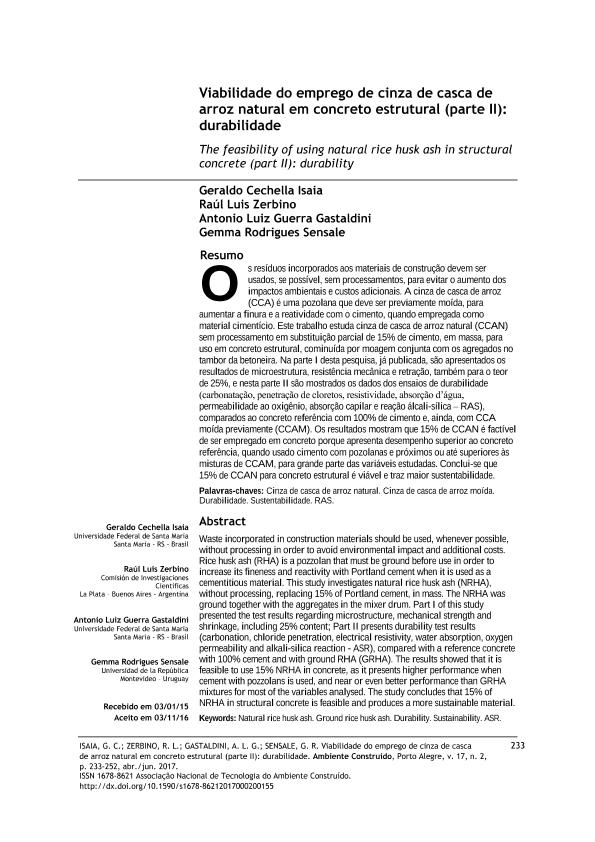Mostrar el registro sencillo del ítem
dc.contributor.author
Isaia, Geraldo Cechella
dc.contributor.author
Zerbino, Raul Luis

dc.contributor.author
Gastaldini, Antonio Luiz Guerra
dc.contributor.author
Sensale, Gemma Rodrigues
dc.date.available
2018-07-10T22:09:47Z
dc.date.issued
2017-06
dc.identifier.citation
Isaia, Geraldo Cechella; Zerbino, Raul Luis; Gastaldini, Antonio Luiz Guerra; Sensale, Gemma Rodrigues; Viabilidade do emprego de cinza de casca de arroz natural em concreto estrutural (parte II): durabilidade; Associação Nacional de Tecnologia do Ambiente Construído; Ambiente Construído; 17; 2; 6-2017; 233-252
dc.identifier.issn
1415-8876
dc.identifier.uri
http://hdl.handle.net/11336/51694
dc.description.abstract
Waste incorporated in construction materials should be used, whenever possible, without processing in order to avoid environmental impact and additional costs. Rice husk ash (RHA) is a pozzolan that must be ground before use in order to increase its fineness and reactivity with Portland cement when it is used as a cementitious material. This study investigates natural rice husk ash (NRHA), without processing, replacing 15% of Portland cement, in mass. The NRHA was ground together with the aggregates in the mixer drum. Part I of this study presented the test results regarding microstructure, mechanical strength and shrinkage, including 25% content; Part II presents durability test results (carbonation, chloride penetration, electrical resistivity, water absorption, oxygen permeability and alkali-silica reaction - ASR), compared with a reference concrete with 100% cement and with ground RHA (GRHA). The results showed that it is feasible to use 15% NRHA in concrete, as it presents higher performance when cement with pozzolans is used, and near or even better performance than GRHA mixtures for most of the variables analysed. The study concludes that 15% of NRHA in structural concrete is feasible and produces a more sustainable material.
dc.description.abstract
Waste incorporated in construction materials should be used, whenever possible, without processing in order to avoid environmental impact and additional costs. Rice husk ash (RHA) is a pozzolan that must be ground before use in order to increase its fineness and reactivity with Portland cement when it is used as a cementitious material. This study investigates natural rice husk ash (NRHA), without processing, replacing 15% of Portland cement, in mass. The NRHA was ground together with the aggregates in the mixer drum. Part I of this study presented the test results regarding microstructure, mechanical strength and shrinkage, including 25% content; Part II presents durability test results (carbonation, chloride penetration, electrical resistivity, water absorption, oxygen permeability and alkali-silica reaction - ASR), compared with a reference concrete with 100% cement and with ground RHA (GRHA). The results showed that it is feasible to use 15% NRHA in concrete, as it presents higher performance when cement with pozzolans is used, and near or even better performance than GRHA mixtures for most of the variables analysed. The study concludes that 15% of NRHA in structural concrete is feasible and produces a more sustainable material.
dc.format
application/pdf
dc.language.iso
por
dc.publisher
Associação Nacional de Tecnologia do Ambiente Construído
dc.rights
info:eu-repo/semantics/openAccess
dc.rights.uri
https://creativecommons.org/licenses/by-nc-sa/2.5/ar/
dc.subject
Cinza de Casca de Arroz Natural
dc.subject
Cinza de Casca de Arroz MoÍDa
dc.subject
Durabilidade
dc.subject
Sustentabilidade
dc.subject
Ras
dc.subject.classification
Meteorología y Ciencias Atmosféricas

dc.subject.classification
Ciencias de la Tierra y relacionadas con el Medio Ambiente

dc.subject.classification
CIENCIAS NATURALES Y EXACTAS

dc.title
Viabilidade do emprego de cinza de casca de arroz natural em concreto estrutural (parte II): durabilidade
dc.title
The feasibility of using natural rice husk ash in structural concrete (part II): durability
dc.type
info:eu-repo/semantics/article
dc.type
info:ar-repo/semantics/artículo
dc.type
info:eu-repo/semantics/publishedVersion
dc.date.updated
2018-06-21T14:18:43Z
dc.identifier.eissn
1678-8621
dc.journal.volume
17
dc.journal.number
2
dc.journal.pagination
233-252
dc.journal.pais
Brasil

dc.journal.ciudad
Porto Alegre
dc.description.fil
Fil: Isaia, Geraldo Cechella. Universidade Federal de Santa Maria; Brasil
dc.description.fil
Fil: Zerbino, Raul Luis. Provincia de Buenos Aires. Gobernacion. Comision de Investigaciones Cientificas. Laboratorio de Entrenamiento Multidisciplinario para la Investigación Tecnológica; Argentina. Consejo Nacional de Investigaciones Científicas y Técnicas; Argentina
dc.description.fil
Fil: Gastaldini, Antonio Luiz Guerra. Universidade Federal de Santa Maria; Brasil
dc.description.fil
Fil: Sensale, Gemma Rodrigues. Universidad de la República; Uruguay
dc.journal.title
Ambiente Construído
dc.relation.alternativeid
info:eu-repo/semantics/altIdentifier/url/http://ref.scielo.org/jy9jhd
dc.relation.alternativeid
info:eu-repo/semantics/altIdentifier/doi/http://dx.doi.org/10.1590/s1678-86212017000200155
Archivos asociados
